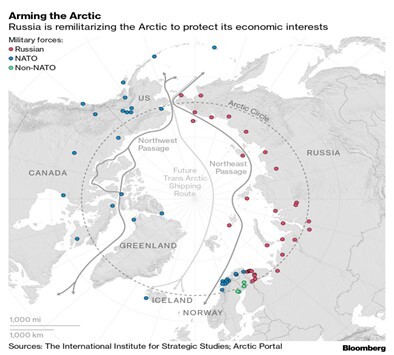In my book, Power Rivals: America and China’s Superpower Struggle, I discuss how China, through its partnership with Russia, is seeking influence and resources in the Arctic Circle.
This underscores why America and investors need to see that the competition between these two adversaries is being played out on a complex global chessboard including Asia, Europe, Latin America, the Middle East, Africa, and yes, even the Arctic Circle.
Russia is the keystone of the Arctic region and in the catbird’s seat as it has sharply expanded the number of icebreakers on active duty. The U.S. Navy doesn’t operate icebreakers, but the Coast Guard currently has only two operational icebreakers in its fleet.
Russia is a steady and determined de facto ally of China due to its history, authoritarian government, and its role as a significant geopolitical and energy player as well as a leading cyber and nuclear threat.
[text_ad]
Our rivalry with China and Russia extends to the Arctic Circle because melting ice has raised hopes of a commercially viable shipping passage open along the 3,500 miles Northern Sea Route from July through November.
Russia claims these northern waters and has been building up military and commercial operations in the region. Beyond reducing shipping transit times from New York to Shanghai by about seven days, there could be substantial resources in the Arctic from rare earths to oil and natural gas.
China, for its part, has announced plans to tie the Northern Sea Route to China’s Maritime Silk Route.
There are other players in the region including Denmark, Sweden, and Finland.
Finland recently joined the North Atlantic Treaty Organization (NATO), and Sweden will likely follow so Russia will then be the only Arctic power that’s not a member of the alliance.
The Arctic Council, the main organization for cooperation in the region, has been suspended since last year. After May 11, Russia hands the chair to Norway.
Who controls the top of the planet, and the resources around it, depends on where you draw the boundaries and international law.
There is also a military aspect to this rivalry as you can see in the below map of the region with Russia being the most aggressive and trying to stake out its turf.
More than a decade ago, Norway proposed expanding its claim to the area by adding 6,000 square miles to its footprint in the high Arctic. Canada’s claim overlaps with Russia’s.
In addition, the Arctic seabed is thought to contain large stores of fossil fuels, metals and critical minerals that will become easier to access as global warming melts the sea ice above.
Twenty years from now, where everything will sit is anyone’s guess. We all hope any developments in the Arctic region will be peaceful and responsible from an environmental point of view.
Cabot Explorer has uncovered an American company well positioned to profit from the rivalry, and recent political developments make it even more probable. Become a member of the Cabot Explorer and learn more about this company in our next issue.
You won’t be disappointed.
[author_ad]

